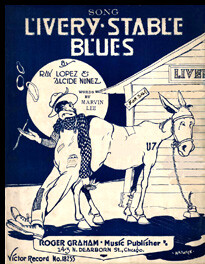 Alcide Nuņez (March 17, 1884 – September 2, 1934) was an early White New Orleans jazz clarinetist. He played with Papa Jack Laine’s Reliance Brass Band, Frank Christian’s Ragtime Band, and Tom Brown’s Band From Dixieland. He was an original member of the Stein’s Dixieland Jass Band and the Original Dixieland Jass Band.
Alcide Nuņez (March 17, 1884 – September 2, 1934) was an early White New Orleans jazz clarinetist. He played with Papa Jack Laine’s Reliance Brass Band, Frank Christian’s Ragtime Band, and Tom Brown’s Band From Dixieland. He was an original member of the Stein’s Dixieland Jass Band and the Original Dixieland Jass Band.
 He was fired from the Original Dixieland Jass Band on Halloween of 1916. He then played for a while in vaudeville bands and with Bert Kelley. Meanwhile in 1917 the Original Dixieland Jass Band had a huge hit with “Livery Stable Blues”.
He was fired from the Original Dixieland Jass Band on Halloween of 1916. He then played for a while in vaudeville bands and with Bert Kelley. Meanwhile in 1917 the Original Dixieland Jass Band had a huge hit with “Livery Stable Blues”.
Nuņez tried to buy arrangements for the song and discovered that it had never been registered for a copyright. As perhaps an act of revenge, Nuņez copyrighted the song along with cornet player Ray Lopez, and published the song and credited themselves with being members of the Original Dixieland Jass Band.
Nick La Rocca and the band sued for $10,000 and quickly copyrighted the song as “Barnyard Blues”. The case became big news in the papers and both La Rocca and Nuņez generated colorful testimony. La Rocca when asked to identify himself in court he said he was the “Columbus of Jazz, the Sir Isaac Newton of the latest dance craze”. Nuņez testified that “Judge, Blues is Blues!”.
The press had a field day with the ten day trial. At the end of the hearings the judge ruled that neither party was entitled to the copyright. It is interesting to note that the flipside to the record was also challenged in court. “Dixie Jass Band One Step” was accused of being a plagiarized version of “That Teasin’ Rag” by Joe Jordan, but the charges didn’t hold up in court and it was dismissed.
Yellow Nuņez returned to New Orleans in 1918 to join another “Jass” band, the Louisiana Five led by drummer Anton Lada. The band moved to New York and played and recorded up until 1920. Nuņez continued to play Jazz up until 1927, when he returned to New Orleans and became a police officer and played in the New Orleans Police Band. Pee Wee Russell claimed that Nuņez was his biggest influence on the clarinet.
| The Story Of The Original Dixieland Jazz Band, by H.O. Brunn, Louisiana State University Press, 1960 |
Redhotjazz.com was a pioneering website during the "Information wants to be Free" era of the 1990s. In that spirit we are recovering the lost data from the now defunct site and sharing it with you.
Most of the music in the archive is in the form of MP3s hosted on Archive.org or the French servers of Jazz-on-line.com where this music is all in the public domain.
Files unavailable from those sources we host ourselves. They were made from original 78 RPM records in the hands of private collectors in the 1990s who contributed to the original redhotjazz.com. They were hosted as .ra files originally and we have converted them into the more modern MP3 format. They are of inferior quality to what is available commercially and are intended for reference purposes only. In some cases a Real Audio (.ra) file from Archive.org will download. Don't be scared! Those files will play in many music programs, but not Windows Media Player.






